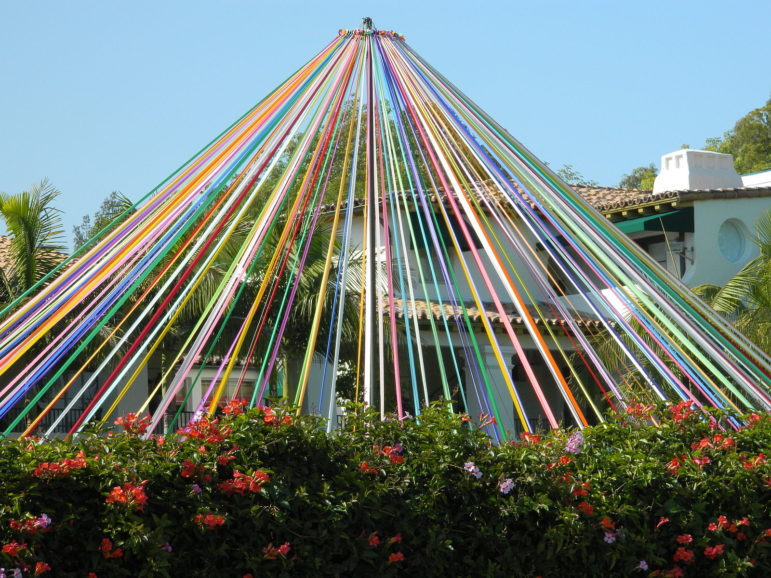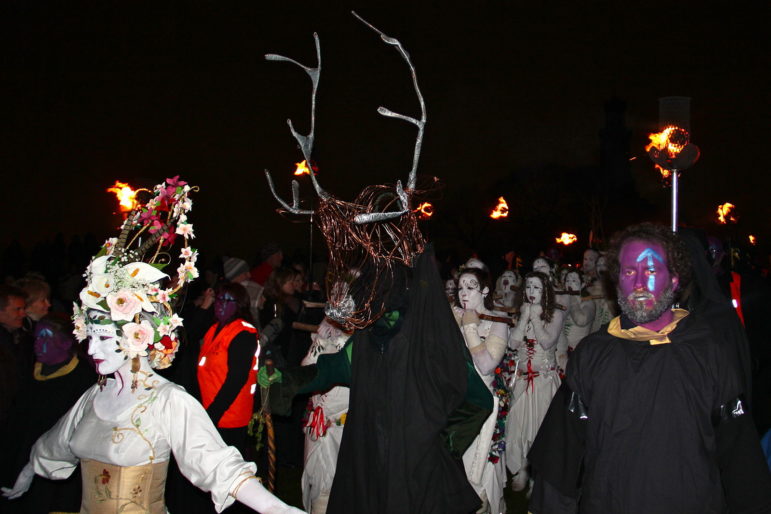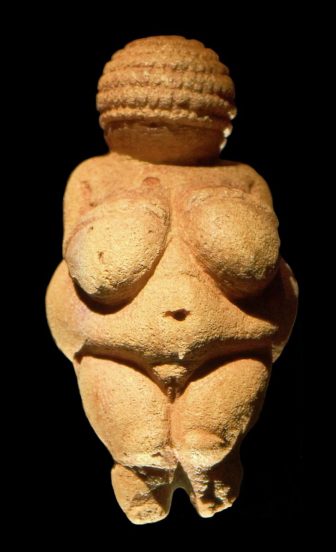
Pagans in the northern hemisphere are getting ready to celebrate the holiday of Beltane, the much-beloved sabbat of modern Witches everywhere who love a good shag.
The modern celebration is loosely based on several pre-Christian May festivals, the earliest of which dates back to ancient Rome. The Floralia was observed on April 27 and celebrated Flora, the goddess of flowers, with games and a pleasure-seeking atmosphere that included nude dancing by prostitutes.
Around this same period, another May festival, the Maiouma, celebrated Dionysus and Aphrodite and was reportedly a nocturnal revel held once every three years. This festival could last the entire month and was marked with offerings and enormous banquets. Eventually known as “the Orgies,” it became so wanton and scandalous that it was eventually suppressed during the reign of Emperor Constantine.
Other May Day celebrations would be practiced across Europe, eventually being marked with the performance of maypole dances and the lighting of special bonfires.
For many modern practitioners, the holiday’s emphasis on being a “fertility” festival resonates in deep and personal ways; the phallic maypole erected and thrust into the darkness of the earth is a spiritual observance of a magical polarity that creates and nourishes life. This polarity is most often represented in modern Pagan circles as the male/female gender binary, giving us “the Goddess” paired with “the God,” whose fruitful union is celebrated as the force that brings life to all things.

Maypole in Brentwood, CA 2012 [Author: Jengood, Wikimedia Commons].
If fertility is indeed the basis for such an observance, then queer practitioners should ask what our place is in such a paradigm. While the majority of us can physically reproduce, many of us choose not to. Do we still have a place in a system that seems so obviously specific to heterosexual coupling and its resultant offspring? Or do we need to find our own holidays that speak to our own mysteries? Do we even have to choose?
It has been argued that the gender polarity that acts as a magical foundation for so much of modern witchcraft need not be taken literally, that in the Jungian sense we all have “male” and “female” aspects to our personality, and that the real meaning behind such an observance is in the bringing of these forces together to create a sort of “personal fertility” (pardon the phrase.)
The problem with this is that by doing so, we are still using a model that is based on a heterosexual pairing and assuming that the physical act of procreation is somehow necessary for magical power outside of reproduction. It assumes that “female” must always be tempered by the “male” and vice versa. It ignores that there is a myriad of other possibilities that do not include polarity, fertility, or even binary gender. There are other ways of interpreting the holiday (and the magical system that underlies it) that allow for more meaningful experiences to be had by everyone. Fertility is a powerful and beautiful mystery, to be certain, but it’s not the only one.
Queer people have grown quite skilled in the art of social translation. We see images of heterosexuality around us all the time, in movies, in magazines, and on television. We hear the stories of straight people told again and again. Even though we are not exactly like the people we see or read about, we resonate with something deeper. We can identify with other aspects of the characters or the story and ignore those parts that don’t fit, because some things are universal to the human experience. We recognize and celebrate those things with which we find resonance.By honoring these shared experiences, we better align with each other and gain a greater context by which we can better understand ourselves and our place in the world.

2012 Beltane Fire Festival procession on Calton Hill, Edinburgh, Scotland. [Author: Stefan Schaefer, Wikimedia Commons].
Even speaking historically, things are not quite as cut-and-dried as they might appear. Consider that the term “fertility,” when cited in older anthropological sources, could (and I would argue in some cases should) be viewed as suspect. In Victorian-era academic circles this polite word was often a euphemism for sexual acts, of which open discussion was culturally forbidden.
Often artifacts of a sexual nature were ascribed more “palatable” meanings. The famous “Venus of Willendorf” has long been described as a fertility image, but a case has also been made for the icon being pornographic in nature. Perhaps this was simply what the artist found arousing. Exclusively focusing on reproductive power, as opposed to (gasp! shudder!) the possibility that our ancestors were actually celebrating physical pleasure, has perhaps given us a skewed perspective on what is important to the human experience.
Fertility is vital to the continuation of our species and to the overall food chain, but there are other magics that are also highlighted at this time. Sexual pleasure is first and foremost, at the heart of how I see Beltane. In all of its forms, it is a celebration of desire and of ecstasy.

Venus of Willendorf [Author: MattiasKabel, Wikimedia Commons].
“I affirm the consecration of the grass stain on the dress, the sacrifice of the carpet-burned knees, the choir of orgasm-cries. This is my ritual, this is the holiest of holies. At other times, I affirm other sacraments: the warmth of friendship, the stillness of acceptance, of birth, of death, of giving, of receiving. But at Beltane, I acknowledge the pleasure.”
–Christina, “Letter to a Young Gay Man on Celebrating Beltane”
Pleasure is a major motivator for our species, and sexual pleasure is among the most sought after. (Lok at just how much money the porn industry brings in- it could be bigger than Hollywood or Netflix.) It is one of the things that unites the vast majority of humanity: we, for the most part, like to get it on with each other. Beltane, whether we ascribe to its fertility aspects or not, is a holiday that revels in that pleasure, no matter one’s orientation, gender, preference, or tastes.
In a society that seems increasingly restrictive when it comes to issues of equal rights and bodily autonomy, it is perhaps even more important for us to celebrate what it means to be able to experience pleasure, and to do so in a healthy way. We acknowledge the wisdom of Oscar Wilde when he said, “Everything in moderation, including moderation.” We know we cannot live permanently in throes of passion or in the elation of bliss; we have lives and responsibilities and, hopefully, still-healthy livers.
Still, we can indulge a little bit. Sometimes. Every once in a while. It’s Beltane!
The Wild Hunt is not responsible for links to external content.
To join a conversation on this post:
Visit our The Wild Hunt subreddit! Point your favorite browser to https://www.reddit.com/r/The_Wild_Hunt_News/, then click “JOIN”. Make sure to click the bell, too, to be notified of new articles posted to our subreddit.

Pingback: Storm Faerywolf: Is That a Maypole in Your Pocket, or Are You Just Happy to See Me? – In The Desert Of Set